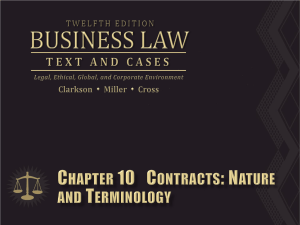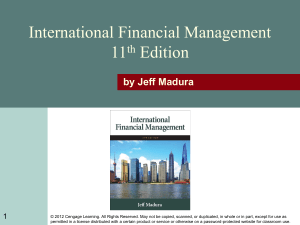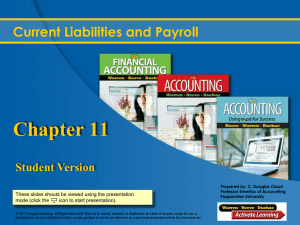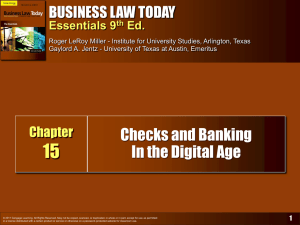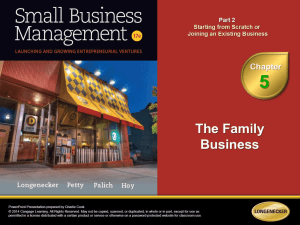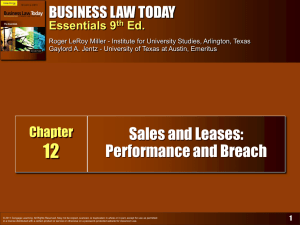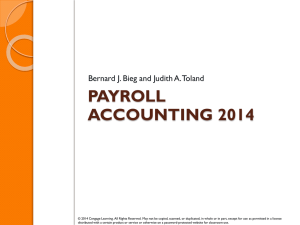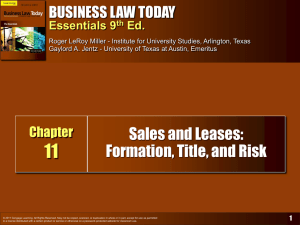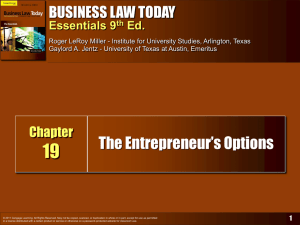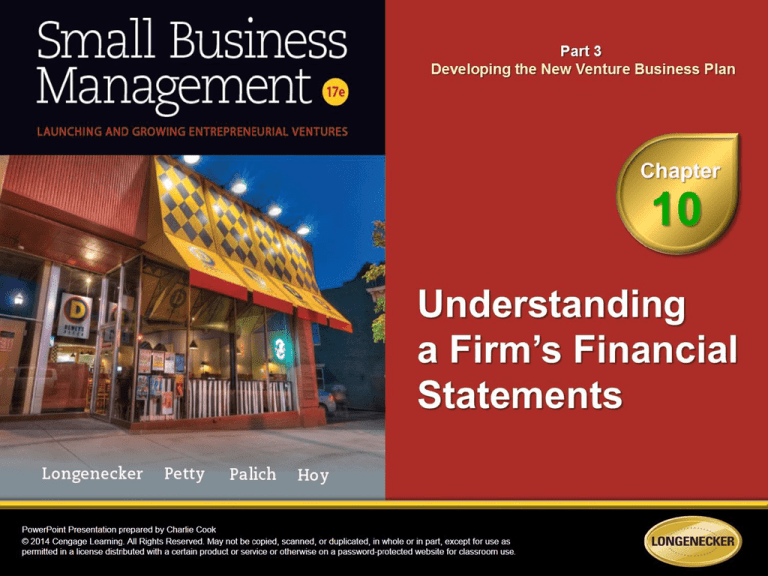
1. Describe the purpose and content
of an income statement.
2. Explain the purpose and content of a balance sheet.
3. Explain how viewing the income statement and balance
sheets together gives a more complete picture of a
firm’s financial position.
4. Use the income statement and balance sheets
to compute a company’s cash flows.
5. Analyze the financial statements using ratios to see
more clearly how decisions affect a firm’s financial
performance.
© 2014 Cengage Learning. All Rights Reserved. May not be copied, scanned, or duplicated, in whole or in part, except for use as
permitted in a license distributed with a certain product or service or otherwise on a password-protected website for classroom use.
10–2
Understanding Financial Statements
• Financial Statements (Accounting Statements)
Reports of a firm’s financial performance and
resources
Helps determine a startup’s financial requirements
Assesses the financial implications
of a business plan
• Basic Financial Statements
Income statement
Balance sheet
Cash flow statement
© 2014 Cengage Learning. All Rights Reserved. May not be copied, scanned, or duplicated, in whole or in part, except for use as
permitted in a license distributed with a certain product or service or otherwise on a password-protected website for classroom use.
10–3
Understanding the Income Statement
• Income Statement
A report showing the profit or loss from a firm’s
operations over a given period of time.
“How profitable is the business?”
Sales (revenue) – Expenses = Profits (income)
– Revenue from product or service sales
– Costs of producing product/service (cost of goods sold)
– Operating expenses (marketing, selling, general and
administrative expenses, and depreciation)
– Financing costs (interest paid)
– Tax payments
© 2014 Cengage Learning. All Rights Reserved. May not be copied, scanned, or duplicated, in whole or in part, except for use as
permitted in a license distributed with a certain product or service or otherwise on a password-protected website for classroom use.
10–4
The Income Statement (cont’d)
• Cost of Goods Sold
The cost of producing or acquiring goods or services
to be sold by a firm
• Gross Profit
Sales less the cost of goods sold
• Operating Expenses
Costs related to marketing and selling a firm’s product
or service, general and administrative expenses, and
depreciation
• Operating Income
Earnings before interest and taxes are paid
© 2014 Cengage Learning. All Rights Reserved. May not be copied, scanned, or duplicated, in whole or in part, except for use as
permitted in a license distributed with a certain product or service or otherwise on a password-protected website for classroom use.
10–5
The Income Statement (cont’d)
• Financing Costs
The amount of interest owed to lenders on borrowed
money
• Net Income Available To Owners (Net Income)
Income that may be distributed to the owners or
reinvested in the company
• Depreciation Expense
Costs related to a fixed asset, such as a building or
equipment, distributed over its useful life
© 2014 Cengage Learning. All Rights Reserved. May not be copied, scanned, or duplicated, in whole or in part, except for use as
permitted in a license distributed with a certain product or service or otherwise on a password-protected website for classroom use.
10–6
10.1
The Income Statement: An Overview
© 2014 Cengage Learning. All Rights Reserved. May not be copied, scanned, or duplicated, in whole or in part, except for use as
permitted in a license distributed with a certain product or service or otherwise on a password-protected website for classroom use.
10–7
The Income Statement (cont’d)
Operating Activities
Financing Activities
Sales Revenue
Operating Income
–
Cost of producing or
acquiring product or
service
(cost of goods sold)
=
Gross profit
–
Marketing and selling
expenses, general and
,
administrative
expenses and
depreciation
(operating expenses)
– Interest expense
on debt
(financing costs)
=
Taxes
Earnings Before Taxes
–
Income taxes
=
Net Income Available
to Owners
Earnings Before Taxes
=
Operating Income
© 2014 Cengage Learning. All Rights Reserved. May not be copied, scanned, or duplicated, in whole or in part, except for use as
permitted in a license distributed with a certain product or service or otherwise on a password-protected website for classroom use.
10–8
10.2
Income Statement for Houser & Associates, Inc.,
for the Year Ending December 31, 2013
Percent of Sales
100%
–65%
35% Gross profit margin
–24%
12% Operating profit margin
–2%
9%
–2%
7% Net profit margin
© 2014 Cengage Learning. All Rights Reserved. May not be copied, scanned, or duplicated, in whole or in part, except for use as
permitted in a license distributed with a certain product or service or otherwise on a password-protected website for classroom use.
10–9
The Balance Sheet
• Balance Sheet
A report showing a firm’s assets, liabilities, and
owners’ equity at a specific point in time
Total Assets = Debt + Owner’s equity
© 2014 Cengage Learning. All Rights Reserved. May not be copied, scanned, or duplicated, in whole or in part, except for use as
permitted in a license distributed with a certain product or service or otherwise on a password-protected website for classroom use.
10–10
10.3
The Balance Sheet: An Overview
© 2014 Cengage Learning. All Rights Reserved. May not be copied, scanned, or duplicated, in whole or in part, except for use as
permitted in a license distributed with a certain product or service or otherwise on a password-protected website for classroom use.
10–11
The Balance Sheet: Current Assets
• Current Assets (Working Capital)
Assets that can be converted to cash within the firm’s
operating cycle
Cash
Currency and negotiable instruments
Accounts receivable
Amount of credit extended to customers that is currently
outstanding
Inventory
Raw materials and products held in anticipation of sale
© 2014 Cengage Learning. All Rights Reserved. May not be copied, scanned, or duplicated, in whole or in part, except for use as
permitted in a license distributed with a certain product or service or otherwise on a password-protected website for classroom use.
10–12
10.4
The Working Capital Cycle
© 2014 Cengage Learning. All Rights Reserved. May not be copied, scanned, or duplicated, in whole or in part, except for use as
permitted in a license distributed with a certain product or service or otherwise on a password-protected website for classroom use.
10–13
The Balance Sheet: Fixed Assets
• Fixed Assets (Plant, Property, and Equipment)
Relatively permanent resources intended for use in
the business (not for resale)
• Depreciable Assets
Assets whose value declines (depreciates) over time
• Gross Fixed Assets
Original cost of depreciable assets before any
depreciation expense has been taken
• Accumulated Depreciation
Total depreciation expense taken over the assets’ life
© 2014 Cengage Learning. All Rights Reserved. May not be copied, scanned, or duplicated, in whole or in part, except for use as
permitted in a license distributed with a certain product or service or otherwise on a password-protected website for classroom use.
10–14
The Balance Sheet: Fixed Assets (cont’d)
• Net Fixed Assets
Gross fixed assets less accumulated depreciation
• Other Assets
Assets other than current assets and fixed assets,
such as patents, copyrights, and goodwill that have
an estimated value
© 2014 Cengage Learning. All Rights Reserved. May not be copied, scanned, or duplicated, in whole or in part, except for use as
permitted in a license distributed with a certain product or service or otherwise on a password-protected website for classroom use.
10–15
The Balance Sheet: Debt
• Debt
Business financing provided by a creditor
• Current Debt (Short-Term Liabilities)
Accounts payable: trade credit payable to suppliers
Accrued expenses: short-term liabilities incurred but not paid
Short-term notes: Cash amounts borrowed that must be
repaid within a short period of time
• Long-Term Debt
Loans and mortgages with maturities greater than
one year
© 2014 Cengage Learning. All Rights Reserved. May not be copied, scanned, or duplicated, in whole or in part, except for use as
permitted in a license distributed with a certain product or service or otherwise on a password-protected website for classroom use.
10–16
The Balance Sheet: Debt (cont’d)
• Mortgage
A long-term loan from a creditor for which real estate
is pledged as collateral.
© 2014 Cengage Learning. All Rights Reserved. May not be copied, scanned, or duplicated, in whole or in part, except for use as
permitted in a license distributed with a certain product or service or otherwise on a password-protected website for classroom use.
10–17
The Balance Sheet: Types of Financing
• Owners’ Equity
Money that the owners invest in the business
Owners are “residual owners” of the firm.
Creditors have first claim on the assets of the firm.
• Retained earnings
Profits less withdrawals (dividends) over the life of the
business
Owners’
Owners’
equity = investment +
Cumulative Cumulative dividends
–
profits
paid to owners
Owners’
Owners’
Earnings retained
equity = investment + within the business
© 2014 Cengage Learning. All Rights Reserved. May not be copied, scanned, or duplicated, in whole or in part, except for use as
permitted in a license distributed with a certain product or service or otherwise on a password-protected website for classroom use.
10–18
10.5
Balance Sheets for Houser & Associates, Inc.,
for December 31, 2012 and 2013
© 2014 Cengage Learning. All Rights Reserved. May not be copied, scanned, or duplicated, in whole or in part, except for use as
permitted in a license distributed with a certain product or service or otherwise on a password-protected website for classroom use.
10–19
10.6
The Fit of the Income Statement and Balance Sheet
© 2014 Cengage Learning. All Rights Reserved. May not be copied, scanned, or duplicated, in whole or in part, except for use as
permitted in a license distributed with a certain product or service or otherwise on a password-protected website for classroom use.
10–20
The Cash Flow Statement
• Cash Flow Statement
A financial report showing a firm’s income (cash)
when it is received and expenses when they are paid.
Cash flows from normal operations (operating activities)
Cash flows related to the investment in or sale of assets
(investment activities)
Cash flows related to financing the firm
(financing activities)
© 2014 Cengage Learning. All Rights Reserved. May not be copied, scanned, or duplicated, in whole or in part, except for use as
permitted in a license distributed with a certain product or service or otherwise on a password-protected website for classroom use.
10–21
Profits Versus Cash Flows
• Accrual-Basis Accounting
Matches revenues when they are earned against the
expenses associated with those revenues.
Sales reflect both cash and credit (noncash) sales.
Inventory purchased on credit is a noncash expense.
Depreciation is a noncash expense.
Income tax is accrued and not entirely expensed.
• Cash-Basis Accounting
Reports transactions only when cash is received or a
payment is made.
© 2014 Cengage Learning. All Rights Reserved. May not be copied, scanned, or duplicated, in whole or in part, except for use as
permitted in a license distributed with a certain product or service or otherwise on a password-protected website for classroom use.
10–22
Measuring Cash Flows
• Cash Flows from Daily Operations
Net cash flows generated from operating a business
Calculated by adding back to operating income depreciation,
deducting income taxes, and factoring in any changes in net
working capital.
• Adjusted Income
After-tax cash flow
• Net Working Capital
Money invested in current assets less accounts
payable and accruals
© 2014 Cengage Learning. All Rights Reserved. May not be copied, scanned, or duplicated, in whole or in part, except for use as
permitted in a license distributed with a certain product or service or otherwise on a password-protected website for classroom use.
10–23
Measuring Cash Flows (cont’d)
• Cash Flows from Investment Activities
Cash inflows and outflows resulting from the sale or
purchase of equipment or another depreciable asset
• Cash Flows from Financing Activities
Cash inflows and outflows resulting from:
Paying dividends and interest expense.
Increasing or decreasing short-term and long-term debt.
Issuing or repurchasing stock.
© 2014 Cengage Learning. All Rights Reserved. May not be copied, scanned, or duplicated, in whole or in part, except for use as
permitted in a license distributed with a certain product or service or otherwise on a password-protected website for classroom use.
10–24
Computing Cash Flows from Assets
After-Tax Cash Flows
from Operations
Changes in
Operating
Working Capital
Cash
Flows
from Assets
Cash
After-tax cash flows
flows from =
from operations
assets
Investments in
operating
working capital
© 2014 Cengage Learning. All Rights Reserved. May not be copied, scanned, or duplicated, in whole or in part, except for use as
permitted in a license distributed with a certain product or service or otherwise on a password-protected website for classroom use.
Changes in
Long-Term
Assets
Investments
in long-term
assets
10–25
Computing Other Cash Flows
• After-Tax Cash Flows From Operations
After-tax
cash
= Net income
flows from
operations
Depreciation
+ expense
+
Interest
Expense
• Operating Working Capital
Operating
Working
Capital
=
Current
assets
–
© 2014 Cengage Learning. All Rights Reserved. May not be copied, scanned, or duplicated, in whole or in part, except for use as
permitted in a license distributed with a certain product or service or otherwise on a password-protected website for classroom use.
Account payable
and accruals
10–26
10.7
Cash Flow Statement for Houser & Associates, Inc.,
for the Year Ending December 31, 2013
© 2014 Cengage Learning. All Rights Reserved. May not be copied, scanned, or duplicated, in whole or in part, except for use as
permitted in a license distributed with a certain product or service or otherwise on a password-protected website for classroom use.
10–27
Cash Flows from Financing
Increase in Debt
Increase in Equity
(firm issues new debt)
(firm issues new stock)
Increases in Cash Flows from Financing
Cash Flows
from Financing
Decreases in Cash Flows from Financing
Interest and Dividends
Paid to Investors
Decrease in Debt
(firm repays debt)
© 2014 Cengage Learning. All Rights Reserved. May not be copied, scanned, or duplicated, in whole or in part, except for use as
permitted in a license distributed with a certain product or service or otherwise on a password-protected website for classroom use.
Decrease in Equity
(firm repurchases
outstanding stock)
10–28
Evaluating a Firm’s
Financial Performance
• Factors Impacting the Firm’s Financial Situation
The firm’s ability to pay its debt as it comes due.
The firm’s profitability from assets.
The amount of debt the business is using.
The rate of return earned by the owners on their
equity investment.
• Financial Leverage
The impact (positive or negative) of financing with
debt rather than with equity.
© 2014 Cengage Learning. All Rights Reserved. May not be copied, scanned, or duplicated, in whole or in part, except for use as
permitted in a license distributed with a certain product or service or otherwise on a password-protected website for classroom use.
10–29
10.8
Financial Ratio Analysis for Houser & Associates, Inc.
© 2014 Cengage Learning. All Rights Reserved. May not be copied, scanned, or duplicated, in whole or in part, except for use as
permitted in a license distributed with a certain product or service or otherwise on a password-protected website for classroom use.
10–30
10.9
Return on Assets: An Overview
© 2014 Cengage Learning. All Rights Reserved. May not be copied, scanned, or duplicated, in whole or in part, except for use as
permitted in a license distributed with a certain product or service or otherwise on a password-protected website for classroom use.
10–31
Looking Ahead: Financial Forecasting
• Pro Forma Financial Statements
Statements that project a firm’s financial performance
and condition
Purposes of pro forma statements:
How profitable can the firm be expected to be, given the
projected sales levels and the expected sales expense
relationships?
What will determine the amount and type of financing (debt or
equity) to be used?
Will the firm have adequate cash flows? If so, how will they
be used; if not, where will the additional cash come from?
© 2014 Cengage Learning. All Rights Reserved. May not be copied, scanned, or duplicated, in whole or in part, except for use as
permitted in a license distributed with a certain product or service or otherwise on a password-protected website for classroom use.
10–32
Key Terms
accounts payable (trade credit)
accounts receivable
accrual-basis accounting
accrued expenses
accumulated depreciation
balance sheet
cash
cash-basis accounting
cash flow activities
cash flow statement
common stock
cost of goods sold
current assets (working capital)
current debt (short-term liabilities)
current ratio
debt
debt ratio
depreciable assets
depreciation expense
dividend
financial leverage
financial statements (accounting
statements)
fixed assets (property, plant and
equipment [PPE])
gross fixed assets
gross profit
© 2014 Cengage Learning. All Rights Reserved. May not be copied, scanned, or duplicated, in whole or in part, except for use as
permitted in a license distributed with a certain product or service or otherwise on a password-protected website for classroom use.
10–33
Key Terms
income statement (profit and loss
statement)
interest expense
inventory
liquidity
long-term debt
long-term notes
mortgage
net fixed assets
net profits
operating expenses
operating profit margin
operating profits
other assets
owners’ equity
profit margins
profits before taxes (taxable
profits)
retained earnings
return on assets
return on equity
short-term notes
total asset turnover
working capital cycle
© 2014 Cengage Learning. All Rights Reserved. May not be copied, scanned, or duplicated, in whole or in part, except for use as
permitted in a license distributed with a certain product or service or otherwise on a password-protected website for classroom use.
10–34

